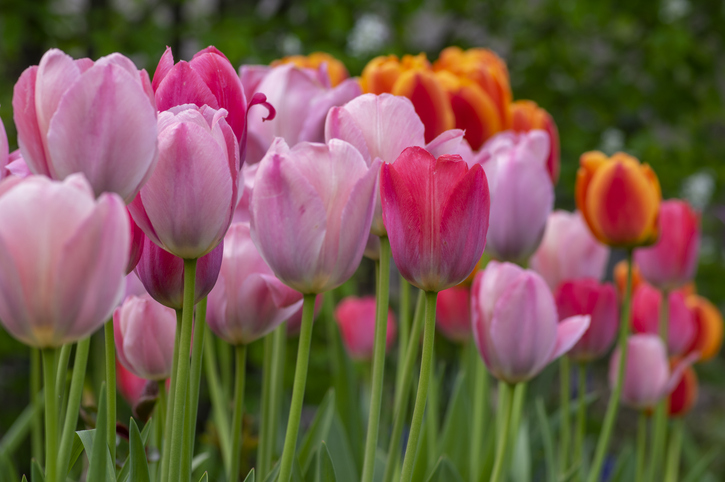A Flowering Industry

Posted on 20 Mar 2024
“The earth laughs in flowers.” – Ralph Waldo Emerson.
Flowers may well be some of the most poetic and romanticized of plants, attracting artists throughout human history to capture their inane beauty and variety. However, today they are also among the most traded and financially viable of agricultural commodities.
The Dutch exported over £250 million worth of tulips alone in 2021, approximately 90% of all the world’s tulips, with 11.4 billion flowers and plants being traded.
Tulipmania
This stable and well established form of agriculture has not been without its past dramas however.
The tulip family tree originates from lilies, and other herbaceous Asian plants, with the first tulip bulb (tulband) being brought to the Netherlands by a Dutch shipping merchant from Asia, via Turkey. The name is thought to have originated from the Turbans worn by Turkish men.
The 17th-century Dutch tulip industry grew rapidly, helped by the ideal growing climate for tulip bulbs in the Netherlands, and the excellent transport links from the fields to the markets, via the network of canals.
The mid-1600s witnessed a staggering phenomenon in the Netherlands, known as Tulipmania. Financial speculation caused the price of Dutch tulips to grow at a staggering rate. Merchants, confident in their investments, would borrow vast sums of money to purchase bulbs, in the apparent certainty that they would be able to sell them at a later date for a profit. At one stage, the best single bulbs were selling for an estimated £750,000 each, with average ones selling for between £50,000 and £150,000. The feeling at the time was that prices would continue to rise indefinitely, and that the return on investments were all but guaranteed.
Unfortunately for the traders, by 1637 the price of bulbs started to dip slightly, causing a now familiar snowballing financial ‘crash’ situation where traders were selling their bulbs for below their previous values. Many were forced into bankruptcy, with the overall Dutch economy being badly affected.
The story behind ‘Tulipmania’ was also exaggerated by Dutch Calvinists, who painted an exaggerated sense of economic ruin due to their concerns that the tulip-driven consumerism would lead to societal decay.
Today there are over 4000 different varieties of tulips, in just about every color, except blue. The stripes in many of the flowers originated from viruses.
Floriculture

Despite the popularity of bulb growing in the Netherlands, the flower industry (floriculture) that involves flower production, distribution, design and retailing was started in the UK during the 19th century. Today, the global cut flower market is valued at almost £48 billion annually. The traditional industry that covered the three main areas; growers, wholesalers and retailers are changing. The industry is adapting to become more efficient and lower costs by eliminating the need for wholesalers, with many growers selling directly to large retail chains, eCommerce sites and supermarkets. Efficient transportation is also key, with climate control systems used to ensure that the flowers arrive at their destination in pristine condition.
The Effect of Weather
As with many other agricultural sectors, floriculture has been susceptible to the effects of climate and the weather.
Generally, hotter temperatures cause flowers to bloom earlier, creating an unseasonal increase in production, over-supply and lower prices. Conversely, lower temperatures tend to increase the price of blooms, as well as adding the logistical challenges that cold weather brings.
To help reduce the risk of weather on production, to manage the supply of the blooms and maintain consistent pricing, the OpenWeather One Call API 3.0 can be used to give consistent format government weather alerts for any global location. In addition, the Road Risk API can be used to help ensure the blooms arrive safely at their destination, whatever the weather.
In the UK, 80% of cut flowers come via the Netherlands, although an increasingly significant proportion originate in Kenya. Some Kenyan flowers also come straight to the UK on direct flights from Nairobi, where entire terminals at certain airports are dedicated to flights exporting blooms.
The growth of African flower production was helped in the oil crisis of the 1970s, where heating of greenhouses in Northern countries became increasingly expensive compared with the minimal costs enjoyed by countries that had hotter average temperatures. Europe increased their imports from Israel and Morocco, and later east Africa, while US buyers developed trade links with Latin America.
These new areas have ideal weather conditions - the high altitudes meant cooler nights, which many flowers benefit from, and the proximity to the equator gave greater sunlight hours compared with Europe. The change also meant an end to seasonal production and the beginning of a 365-day-a-year international competitive trade.
Kenyan Rose Growth

In the commercial Kenyan rose greenhouses, the soil pH and organic matter is constantly monitored, with drip-irrigation systems that transports water directly to each plant, minimizing waste. Natural pest control is favored over artificial, further reducing the cost of production.
After only 20 weeks of growth, the stems are harvested by hand, placed into a solution of nutrients that promotes further growth, and quickly transferred to a cold store and cooled to 4C before being graded, sorted into bunches in the packing house, and returned to the cold store. Finally, they are transported in a refrigerated lorry to Nairobi’s airport.
About OpenWeather:
OpenWeather provides weather data for any location on the globe using a proprietary hyperlocal forecasting model with a resolution from 500 m to 2 km, globally. More than 6,000,000 customers from logistics, agriculture, insurance, energy, retail, and many other sectors, are working with the company's weather products.
OpenWeather cooperates with global meteorological agencies such as MetOffice and NOAA, and enhances its model with data from radars, weather stations and satellites. The company provides great availability of service at 99.9% for enterprise-level products.
The products can be easily integrated into complex IT systems and are ideal for ML analytic systems. OpenWeather is a member of Royal Meteorological Society and an Achilles-certified supplier. OpenWeather ethical initiatives include support of educators and students, not-for-profit subscriptions for the general public to increase weather awareness, and recent Ukrainian donation programme.
For more information on how to gain access to our OpenWeather products, please email us.





